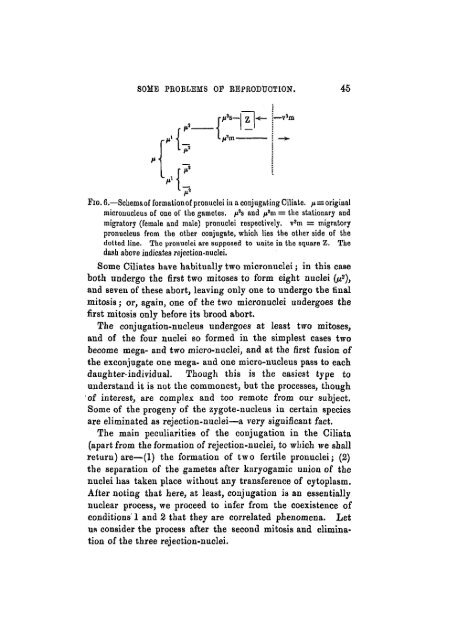Some Problems of Reproduction: a Comparative Study of ...
Some Problems of Reproduction: a Comparative Study of ...
Some Problems of Reproduction: a Comparative Study of ...
Create successful ePaper yourself
Turn your PDF publications into a flip-book with our unique Google optimized e-Paper software.
SOME PROBLEMS OF REPRODUCTION. 45<br />
r/ 3 s-~z~]-<br />
J/«"8- Z<br />
*-u 3 m<br />
•{!<br />
v<br />
V<br />
FIG. 6.—Schema<strong>of</strong> formation<strong>of</strong> pronuclei in a conjugating Ciliate. /t=original<br />
microuuoleu3 <strong>of</strong> one <strong>of</strong> the gametes. /i 3 s and /« 3 m = the stationary and<br />
migratory (female and male) pronuclei respectively. v 3 m = migratory<br />
pronucleus from the other conjugate, which lies the other side <strong>of</strong> the<br />
dotted line. The pronuclei are supposed to unite in the square Z. The<br />
dash above indicates rejection-nuclei.<br />
<strong>Some</strong> Ciliates have habitually two micronuclei; in this case<br />
both undergo the first two mitoses to form eight nuclei (ft 2 ),<br />
and seven <strong>of</strong> these abort, leaving only one to undergo the final<br />
mitosis; or, again, one <strong>of</strong> the two micronuclei undergoes the<br />
first mitosis only before its brood abort.<br />
The conjugation-nucleus undergoes at least two mitoses,<br />
and <strong>of</strong> the four nuclei so formed in the simplest cases two<br />
become mega- and two micro-nuclei, and at the first fusion <strong>of</strong><br />
the exconjugate one mega- and one micro-nucleus pass to each<br />
daughter-individual. Though this is the easiest type to<br />
understand it is not the commonest, but the processes, though<br />
'<strong>of</strong> interest, are complex and too remote from our subject.<br />
<strong>Some</strong> <strong>of</strong> the progeny <strong>of</strong> the zygote-nucleus in certain species<br />
are eliminated as rejection-nuclei—a very significant fact.<br />
The main peculiarities <strong>of</strong> the conjugation in the Ciliata<br />
(apart from the formation <strong>of</strong> rejection-nuclei, to which we shall<br />
return) are—(1) the formation <strong>of</strong> two fertile pronuclei; (2)<br />
the separation <strong>of</strong> the gametes after karyogamic union <strong>of</strong> the<br />
nuclei has taken place without any transference <strong>of</strong> cytoplasm.<br />
After noting that here, at least, conjugation is an essentially<br />
nuclear process, we proceed to infer from the coexistence <strong>of</strong><br />
conditions 1 and 2 that they are correlated phenomena. Let<br />
us consider the process after the second mitosis and elimination<br />
<strong>of</strong> the three rejection-nuclei.

















